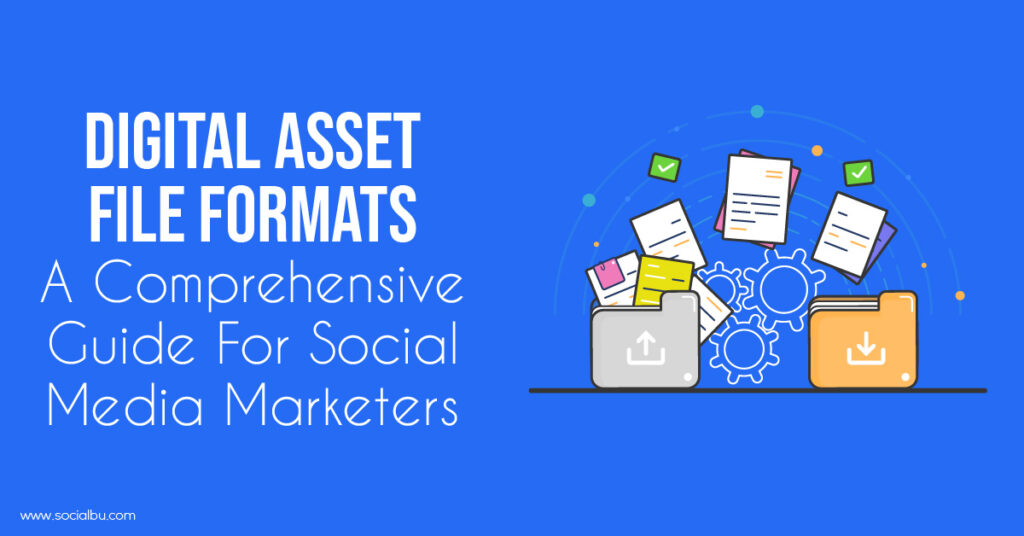In the digital era, an image is worth more than a thousand words—it can be worth thousands of clicks, shares, and likes. However, the impact of your social media content heavily depends on an often overlooked detail: the digital asset file formats.
This comprehensive guide highlights the importance of understanding file formats for social media marketers and maximizing their benefits.
Understanding Digital Asset File Formats
Digital asset file formats are essentially the structure in which digital files are stored and shared. They come in many types, each with unique properties and usage scenarios.

One standard format people often encounter is the Word document format. Nonetheless, it’s sometimes necessary to convert these files into a universal format, like PDF, which can be done with tools like Word to PDF converter.
The fundamental distinction between formats lies in their classification as raster or vector, with raster formats storing information as pixels and vector formats using mathematical equations to depict the design.
Understanding the difference between lossless and lossy compression—the former retains all original data, while the latter eliminates some for a smaller file size—is crucial for preserving image quality.
Common Digital File Formats
There are several digital file formats that you can use for your social media marketing campaigns. Some common ones include:
Image File Formats
When you’re creating visual content, it’s essential to select the most suitable image file format. The usual image file formats you’ll encounter include the following:
- JPEG (Joint Photographic Experts Group): This standard for compressing pictures is optimal for photographs, gradients, and images with many colors. JPEGs can shrink file sizes without significantly losing quality, making them perfect for websites and social media.
- PNG (Portable Network Graphics): These lossless files do not lose quality during editing. PNGs support transparent backgrounds, which makes them ideal for logos or images superimposed on other content.
- GIF (Graphics Interchange Format): This is your go-to for animated images. While GIFs have a limited color range, they are excellent for tiny, straightforward animations, particularly for social media.
Video File Formats
As with image file formats, selecting the correct video format can considerably affect the quality and accessibility of your content. The most common video formats include MP4, MOV, and AVI.
- MPEG-4 Part 14 (MP4): This widely compatible video format compresses videos without significant quality loss and is perfect for sharing on social media and websites.
- QuickTime Movie (MOV): Developed by Apple, this popular format delivers high-quality video. However, its compatibility is more limited than MP4.
- Audio Video Interleave (AVI): This older video format maintains high quality but may result in larger file sizes, making it less suitable for social media.
Audio File Formats
Understanding the format options when dealing with audio files ensures that your sound quality meets the professional standards of your brand. The most commonly used formats include:
- MPEG Audio Layer-3 (MP3): It’s a standard format for compressing audio files while maintaining a decent sound quality. The good thing about MP3 is its compatibility with most platforms, making it ideal for podcasts and other audio content.
- Waveform Audio File Format (WAV): It offers uncompressed, high-quality audio. However, it results in large file sizes and may not be the best choice for all platforms.
- Advanced Audio Coding (AAC): Commonly used for streaming and broadcasting, it’s an audio format that provides better sound quality than MP3 at similar bit rates.
Now that you know the different types of digital formats, it’s time to know how significant it is in social media marketing.
The Importance Of File Formats In Social Media Marketing

File formats directly affect your content’s image quality, load speed, and overall user experience. Superior image quality can capture the audience’s attention more efficiently, increasing engagement rates.
Moreover, faster load speeds enhance SEO ranking and boost user satisfaction, as today’s internet users anticipate quick, seamless online browsing experiences.
In addition, the format’s compatibility across different devices can determine the accessibility of your content. An incompatible file format might prevent your image or video from being viewable on specific devices, limiting your audience reach.
Consequently, understanding and selecting the proper file format is essential for a successful social media strategy, as it can impact your campaign’s reach, engagement, and overall effectiveness.
How To Choose The Right File Format For Your Social Media Content
When selecting the optimal file format for your social media content, there are a few key aspects to consider:
1. Understand Your Audience’s Device And Network Limitations
If your target audience primarily uses mobile devices or resides in areas with slower network speeds, using file formats with smaller sizes (such as JPEG for images or MP4 for videos) can ensure faster load times and better user experiences.
2. Adhere To Platform Guidelines
Each social media platform has its preferred or accepted file formats. For instance, while JPEGs might be optimal for Facebook and Instagram, SVGs can be an ideal choice for high-quality graphics on a website. Follow these guidelines to guarantee that your content displays correctly and effectively.
3. Match The Content With The Correct Format
This involves understanding each format’s strengths and weaknesses. For instance, GIFs are great for short, looping animations, whereas PNGs are better for images that require transparency.
4. Balance Quality And File Size
Striking a balance is crucial, ensuring your content is high-quality and easily accessible. For example, consider using lossy compression formats like JPEG for detailed images, where a minor loss in quality might not be noticeable but can reduce the file size.
These considerations allow you to select the file format best suits your needs. This way, you can be sure that your content reaches its intended audience most effectively and efficiently as possible.
Conclusion
Understanding digital asset file formats goes beyond merely knowing what acronyms stand for. It’s about guaranteeing your brand delivers the highest quality content in the most efficient way possible. Make the right choice, and you’ll maintain the professional standards your audience expects. After all, in the fast-paced world of social media marketing, small details make a huge difference.







